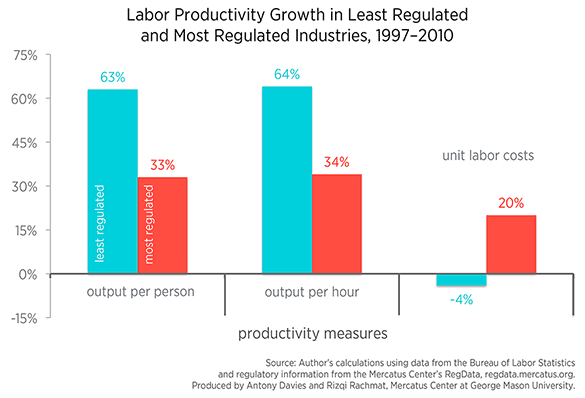- | Regulation Regulation
- | Data Visualizations Data Visualizations
- |
More-Regulated Industries Experience Lower Productivity Growth
When confronted with regulation, producers are likely to alter production levels and processes in ways that they would not have otherwise chosen. We also expect competition to decline in heavily regulated markets since the burden imposed by regulation functions as a barrier to new firms who wish to enter the market. Consequently, productivity in industries should decline as the regulatory burden placed on them increases.

When confronted with regulation, producers are likely to alter production levels and processes in ways that they would not have otherwise chosen. We also expect competition to decline in heavily regulated markets since the burden imposed by regulation functions as a barrier to new firms who wish to enter the market. Consequently, productivity in industries should decline as the regulatory burden placed on them increases. From 1997 through 2010, productivity in the least regulated industries grew almost twice as fast as in the most regulated industries.
Regulatory burden is measured using RegData, a text analysis tool that counts the number of binding words—“shall,” “must,” “may not,” “prohibited,” and “required”—that appear in the Code of Federal Regulations and cross-references those word counts with the industries to which they apply. Comparing this data to production-efficiency measures from the Bureau of Labor Statistics shows that industries that are subject to less regulation have significantly higher production-efficiency measures than industries that are subject to more regulation.
From 1997 through 2010, the least regulated industries experienced 63-percent growth in output per person, 64-percent growth in output per hour, and a four-percent decline in unit labor costs. Over the same period, the most regulated industries experienced 33-percent growth in output per person, 34-percent growth in output per hour, and a 20-percent increase in unit labor costs. The data appear to confirm that greater regulatory burden is associated with lower levels of industry productivity.
